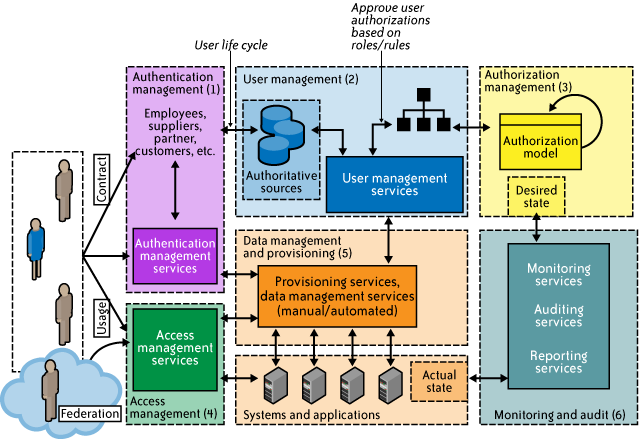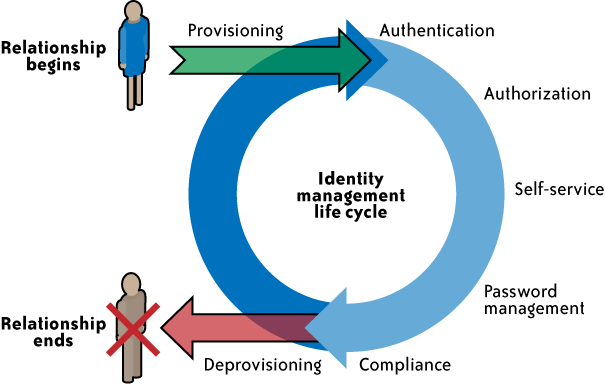1. IAM Challenges
One critical challenge of IAM concerns managing access for diverse user populations (employees, contractors, partners, etc.) accessing internal and externally hosted services. IT is constantly challenged to rapidly provision appropriate access to the users whose roles and responsibilities often change for business reasons. Another issue is the turnover of users within the organization. Turnover varies by industry and function—seasonal staffing fluctuations in finance departments, for example—and can also arise from changes in the business, such as mergers and acquisitions, new product and service releases, business process outsourcing, and changing responsibilities. As a result, sustaining IAM processes can turn into a persistent challenge.
Access policies for information are seldom centrally and consistently applied. Organizations can contain disparate directories, creating complex webs of user identities, access rights, and procedures. This has led to inefficiencies in user and access management processes while exposing these organizations to significant security, regulatory compliance, and reputation risks.
To address these challenges and risks, many companies have sought technology solutions to enable centralized and automated user access management. Many of these initiatives are entered into with high expectations, which is not surprising given that the problem is often large and complex. Most often those initiatives to improve IAM can span several years and incur considerable cost. Hence, organizations should approach their IAM strategy and architecture with both business and IT drivers that address the core inefficiency issues while preserving the control’s efficacy (related to access control). Only then will the organizations have a higher likelihood of success and return on investment.
2. IAM Definitions
To start, we’ll present the basic concepts and definitions of IAM functions for any service:
- Authentication
-
Authentication is the process of verifying the identity of a user or system (e.g., Lightweight Directory Access Protocol [LDAP] verifying the credentials presented by the user, where the identifier is the corporate user ID that is unique and assigned to an employee or contractor). Authentication usually connotes a more robust form of identification. In some use cases, such as service-to-service interaction, authentication involves verifying the network service requesting access to information served by another service (e.g., a travel web service that is connecting to a credit card gateway to verify the credit card on behalf of the user).
Authorization-
Authorization is the process of determining the privileges the user or system is entitled to once the identity is established. In the context of digital services, authorization usually follows the authentication step and is used to determine whether the user or service has the necessary privileges to perform certain operations—in other words, authorization is the process of enforcing policies.
- Auditing
-
In the context of IAM, auditing entails the process of review and examination of authentication, authorization records, and activities to determine the adequacy of IAM system controls, to verify compliance with established security policies and procedures (e.g., separation of duties), to detect breaches in security services (e.g., privilege escalation), and to recommend any changes that are indicated for countermeasures.
3. IAM Architecture and Practice
IAM is not a monolithic solution that can be easily deployed to gain capabilities immediately. It is as much an aspect of architecture (see Figure 1) as it is a collection of technology components, processes, and standard practices. Standard enterprise IAM architecture encompasses several layers of technology, services, and processes. At the core of the deployment architecture is a directory service (such as LDAP or Active Directory) that acts as a repository for the identity, credential, and user attributes of the organization’s user pool. The directory interacts with IAM technology components such as authentication, user management, provisioning, and federation services that support the standard IAM practice and processes within the organization. It is not uncommon for organizations to use several directories that were deployed for environment-specific reasons (e.g., Windows systems using Active Directory, Unix systems using LDAP) or that were integrated into the environment by way of business mergers and acquisitions.
The IAM processes to support the business can be broadly categorized as follows:
- User management
-
Activities for the effective governance and management of identity life cycles
Authentication management-
Activities for the effective governance and management of the process for determining that an entity is who or what it claims to be
Authorization management-
Activities for the effective governance and management of the process for determining entitlement rights that decide what resources an entity is permitted to access in accordance with the organization’s policies
Access management-
Enforcement of policies for access control in response to a request from an entity (user, services) wanting to access an IT resource within the organization
Data management and provisioning-
Propagation of identity and data for authorization to IT resources via automated or manual processes
Monitoring and auditing-
Monitoring, auditing, and reporting compliance by users regarding access to resources within the organization based on the defined policies
Figure 1. Enterprise IAM functional architecture

IAM processes support the following operational activities:
Provisioning-
This is the process of on-boarding users to systems and applications. These processes provide users with necessary access to data and technology resources. The term typically is used in reference to enterprise-level resource management. Provisioning can be thought of as a combination of the duties of the human resources and IT departments, where users are given access to data repositories or systems, applications, and databases based on a unique user identity. Deprovisioning works in the opposite manner, resulting in the deletion or deactivation of an identity or of privileges assigned to the user identity.
Credential and attribute management-
These processes are designed to manage the life cycle of credentials and user attributes—create, issue, manage, revoke—to minimize the business risk associated with identity impersonation and inappropriate account use. Credentials are usually bound to an individual and are verified during the authentication process. The processes include provisioning of attributes, static (e.g., standard text password) and dynamic (e.g., one-time password) credentials that comply with a password standard (e.g., passwords resistant to dictionary attacks), handling password expiration, encryption management of credentials during transit and at rest, and access policies of user attributes (privacy and handling of attributes for various regulatory reasons).
Entitlement management-
Entitlements are also referred to as authorization policies. The processes in this domain address the provisioning and deprovisioning of privileges needed for the user to access resources including systems, applications, and databases. Proper entitlement management ensures that users are assigned only the required privileges (least privileges) that match with their job functions. Entitlement management can be used to strengthen the security of web services, web applications, legacy applications, documents and files, and physical security systems.
Compliance management-
This process implies that access rights and privileges are monitored and tracked to ensure the security of an enterprise’s resources. The process also helps auditors verify compliance to various internal access control policies, and standards that include practices such as segregation of duties, access monitoring, periodic auditing, and reporting. An example is a user certification process that allows application owners to certify that only authorized users have the privileges necessary to access business-sensitive information.
Identity federation management-
Federation is the process of managing the trust relationships established beyond the internal network boundaries or administrative domain boundaries among distinct organizations. A federation is an association of organizations that come together to exchange information about their users and resources to enable collaborations and transactions (e.g., sharing user information with the organizations’ benefits systems managed by a third-party provider). Federation of identities to service providers will support SSO to cloud services.
Centralization of authentication (authN) and authorization (authZ)-
A central authentication and authorization infrastructure alleviates the need for application developers to build custom authentication and authorization features into their applications. Furthermore, it promotes a loose coupling architecture where applications become agnostic to the authentication methods and policies. This approach is also called an “externalization of authN and authZ” from applications.
Figure 2 illustrates the identity life cycle management phases.
Figure 2. Identity life cycle


